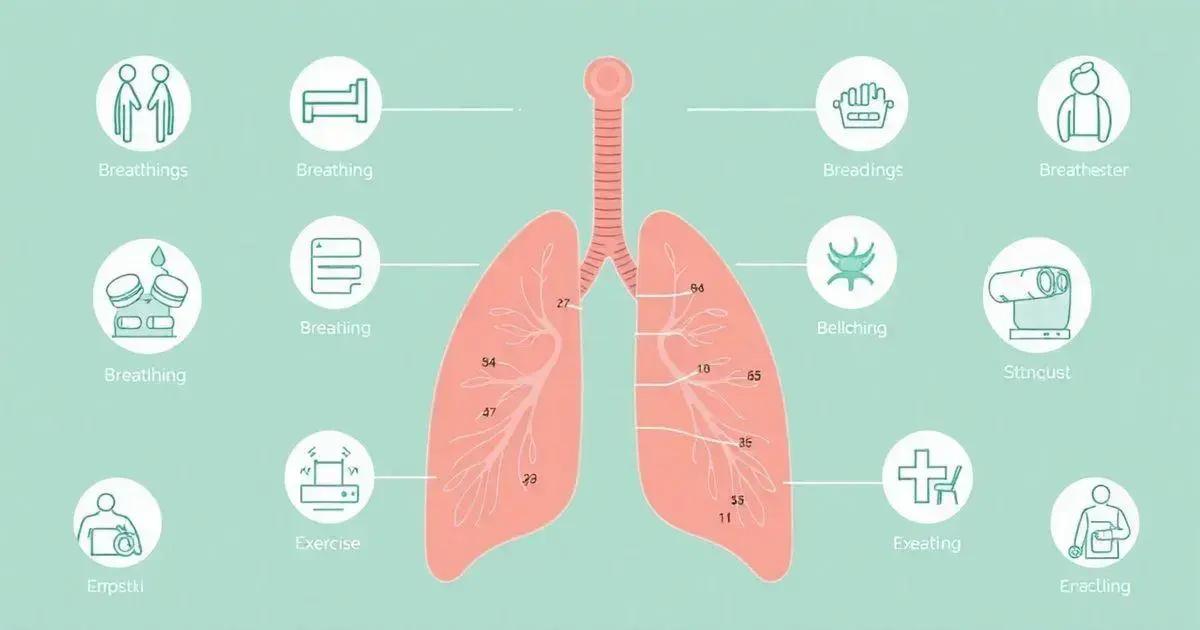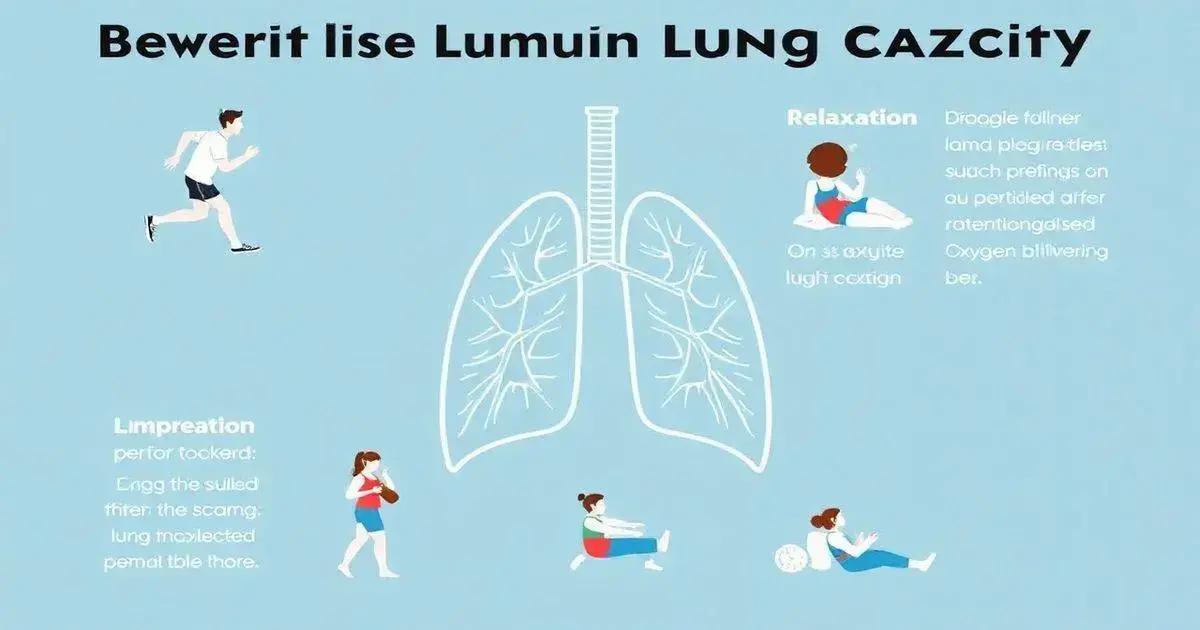To increase lung capacity with breathing exercises, practice techniques like diaphragmatic breathing, pursed lip breathing, and box breathing regularly. These exercises enhance oxygen intake, improve athletic performance, reduce breathlessness, and promote overall lung health.
Increasing your lung capacity with breathing exercises is essential for enhancing athletic performance and overall health. Engaging in these targeted techniques not only improves oxygen intake but also promotes relaxation and stress relief. In this article, we will delve into various exercises designed to boost your lung capacity, explore their benefits, and provide you with tips for effective practice. Let’s take a deep breath and discover how these exercises can transform your breathing!
Understanding Lung Capacity

Understanding lung capacity is crucial for maximizing your breathing efficiency. Lung capacity refers to the amount of air your lungs can hold. It affects how well your body can utilize oxygen, which is essential for overall health and physical performance.
Types of Lung Capacity
Lung capacity can be divided into several components. These include:
- Tidal Volume: This is the amount of air you inhale or exhale during normal breathing.
- Vital Capacity: This refers to the maximum amount of air you can exhale after a maximum inhale.
- Total Lung Capacity: This is the total volume of air your lungs can hold, including all types of air mentioned above.
Factors Affecting Lung Capacity
Various factors influence lung capacity, such as age, gender, physical fitness, and altitude. For instance, younger people typically have greater lung capacity than older individuals. Similarly, athletes often have better lung capacity due to their training.
Health conditions like asthma or chronic obstructive pulmonary disease (COPD) can also negatively impact lung capacity. Therefore, understanding and monitoring your lung capacity is important for maintaining good health.
The Role of Breathing Exercises
Breathing exercises can help increase lung capacity. These practices strengthen the muscles involved in breathing and improve the elasticity of the lungs. By incorporating these exercises into your routine, you can enhance your lung function and overall stamina.
Breathing Exercises for Increased Capacity

Breathing exercises are effective techniques to increase lung capacity. These exercises help to strengthen the respiratory muscles and improve the efficiency of oxygen exchange in your body.
1. Diaphragmatic Breathing
This type of breathing focuses on using the diaphragm, a key muscle involved in respiration. Here’s how to do it:
- Find a comfortable position, either sitting or lying down.
- Place one hand on your chest and the other on your abdomen.
- Breathe in deeply through your nose, ensuring that your abdomen rises while your chest remains still.
- Exhale slowly through pursed lips, letting your abdomen fall.
2. Pursed Lip Breathing
Pursed lip breathing helps to control your breath and increase lung capacity:
- Inhale deeply through your nose for two counts.
- Purse your lips as if you are going to whistle.
- Exhale slowly through your pursed lips for four counts.
3. Box Breathing
This exercise helps to regulate your breathing and can be very calming:
- Inhale deeply through your nose for a count of four.
- Hold your breath for another count of four.
- Exhale slowly through your mouth for a count of four.
- Hold your breath again for a count of four.
4. Breath Counting
This exercise improves focus on your breathing:
- Find a quiet place to sit or lie down.
- Take a deep breath in and out, then start counting your breaths.
- Count each inhale and exhale cycle up to ten, then start over.
These breathing exercises can be practiced daily. Over time, you’ll notice improvements in your lung capacity and overall well-being.
Benefits of Improved Lung Capacity

Improved lung capacity offers numerous health benefits that can enhance your quality of life. Here are several advantages that come with increased lung capacity:
1. Enhanced Athletic Performance
With better lung capacity, athletes can take in more oxygen, which can lead to improved stamina and endurance. This allows for longer training sessions and increased performance during competitions.
2. Better Oxygen Delivery
Improved lung capacity means more oxygen is delivered to your muscles and organs. This helps them function more efficiently, leading to better overall health. Optimal oxygen levels can also enhance cognitive performance.
3. Reduced Breathlessness
People with increased lung capacity often experience less breathlessness, even during physical exertion. This can make everyday activities, like walking or climbing stairs, easier and more enjoyable.
4. Stress Relief and Relaxation
Breathing exercises that boost lung capacity promote relaxation by reducing stress. Proper breathing techniques can calm your nervous system and aid in mental well-being.
5. Improved Lung Health
Practicing breathing exercises can help clear stale air from your lungs, reducing the risk of respiratory issues. Stronger lungs can also fight infections better, contributing to your overall health and vitality.
6. Better Sleep Quality
Improved lung capacity can enhance your breathing during sleep, leading to better quality sleep. This helps you wake up feeling more refreshed and energized.
Overall, the benefits of increased lung capacity are significant and can greatly contribute to a healthier lifestyle.
Tips for Effective Breathing Techniques

To make the most of your breathing exercises, here are some tips for effective breathing techniques that can enhance your lung capacity:
1. Maintain Good Posture
Proper posture helps keep your airways open. Sit or stand up straight, with your shoulders relaxed. This allows your lungs to expand fully.
2. Start Slowly
When practicing breathing exercises, take your time. Start with 5-10 minutes a day and gradually increase the duration as you become more comfortable.
3. Focus on Your Breath
Pay attention to your breathing pattern. Inhale deeply and feel your abdomen rise. Exhale slowly and notice how your body relaxes.
4. Use Visualization
Imagine clean air filling your lungs and carrying away tension. This mental imagery can help you relax and improve your focus during exercises.
5. Practice Regularly
Consistency is key. Try to practice breathing exercises daily to experience the full benefits and see improvements in your lung capacity over time.
6. Don’t Force Your Breaths
Avoid straining while breathing. The goal is to feel relaxed. If you find it difficult to breathe at any point, take a break and return when you’re more comfortable.
7. Incorporate Breathing Exercises into Other Activities
Try to integrate breathing techniques into your daily routine, like when you are exercising, meditating, or even walking. This can enhance both your physical and mental wellness.
8. Be Patient with Yourself
Improving lung capacity takes time. Celebrate small victories and stay motivated. Over time, you’ll notice significant improvements.
In summary, enhancing your lung capacity through breathing exercises is highly beneficial
Improving lung capacity can lead to better athletic performance, increased efficiency in oxygen delivery, and overall enhanced well-being. By incorporating various effective breathing techniques and practicing them regularly, you can experience reduced breathlessness, lower stress levels, and improved lung health.
Remember to focus on maintaining good posture, starting slowly, and being patient with your progress. With time and consistency, you can enjoy the many health benefits that come with stronger lungs.
Take advantage of these tips and exercises to increase your lung capacity and support a healthier lifestyle.
FAQ – Frequently Asked Questions about Increasing Lung Capacity with Breathing Exercises
What are breathing exercises?
Breathing exercises are techniques designed to strengthen your respiratory muscles and increase lung capacity, improving overall breathing efficiency.
How can breathing exercises benefit my health?
Breathing exercises can enhance lung capacity, reduce breathlessness, improve oxygen delivery, relieve stress, and promote better sleep quality.
How often should I practice breathing exercises?
For best results, aim to practice breathing exercises daily, starting with 5-10 minutes and gradually increasing the duration as you become more comfortable.
Can anyone practice breathing exercises?
Yes, breathing exercises can be beneficial for individuals of all ages and fitness levels. However, it’s best to consult a healthcare professional if you have specific health concerns.
What is diaphragmatic breathing?
Diaphragmatic breathing is a technique that focuses on using the diaphragm to allow fuller oxygen intake, promoting relaxation and more effective breathing.
Are there any risks involved with breathing exercises?
Breathing exercises are generally safe, but it’s important to avoid straining. If you feel lightheaded or uncomfortable, pause and resume when you’re ready.












